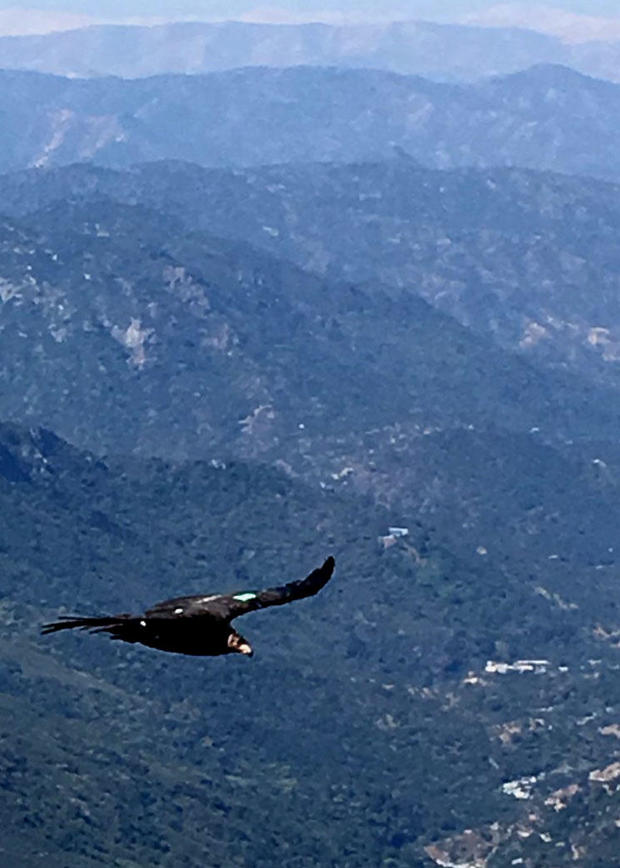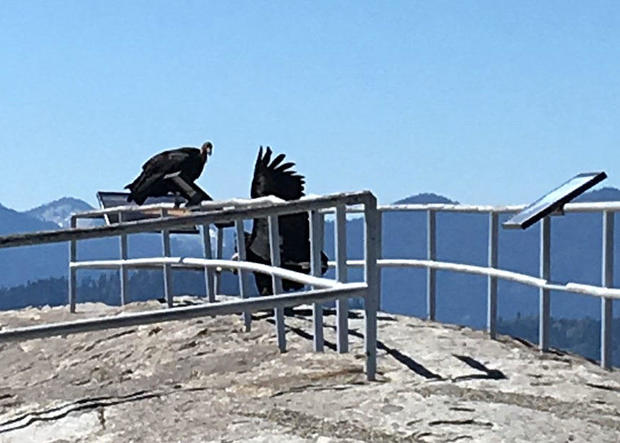Endangered California condors spotted in Sequoia National Park for the first time in nearly 50 years
California condors were recently seen soaring through Sequoia National Park for the first time in nearly 50 years. The giant endangered bird, the largest in North America, was known to nest inside massive sequoia trees before its near-extinction in the 1980s.
Officials from the Pacific Southwest Region of the U.S. Fish and Wildlife Service (USFWS) said at least six condors were observed near the Giant Forest and Moro Rock, a popular hiking destination in the park, in late May. Photos of the birds show two of them gliding through the air and resting on a metal railing.
"Condors were consistently seen throughout the parks until the late 1970s. Observations became increasingly rare throughout the latter portion of the century as the population declined," Tyler Coleman, a wildlife biologist with Sequoia and Kings Canyon National Parks, said in a statement to CBS News on Wednesday.
The Santa Barbara Zoo, using GPS to track the condor population in California, confirmed the exciting find.
"We use GPS transmitters to track the birds' movement, which can be over hundreds of miles on a single day," said Dave Meyer, one of the zoo's biologists. "On this particular day we documented the birds' signals around Giant Forest, and we are excited that park employees observed the birds and confirmed their use of this important historic habitat."
Forty years ago, California condors were on the verge of extinction. Habitat destruction, lead poisoning and poaching all contributed to the bird's decline.
In the 1980s, state and federal wildlife agencies captured the remaining 22 birds in the wild to breed them in captivity in an attempt to revive the species. In 1992, the birds were reintroduced to the wild in California, and later in Arizona.
Each condor, both born in captivity and in the wild, has been closely tracked ever since. The total wild population is now at about 340.
"As biologists, we are excited to see condors continue to expand back into their historic range. And also for the opportunity to engage with the local communities to share what they can do to contribute to the recovery of California condors, and inform them about threats to these birds," said Laura McMahon, a wildlife biologist with USFWS' California Condor Recovery Program.
Lead poisoning is still the primary threat to the species, which scavenge for food. They often feed on the carcasses of dead animals that contain pieces of lead bullets used by hunters.
The Institute for Wildlife Studies is working to educate Californians on the hazards of lead ammunition, as well as researching non-lead bullet options.
"Lead-core bullets shed weight in small fragments as they hit game, and have the potential to poison wildlife, including condors, who scavenge the remains," said Chad Thomas, non-lead outreach coordinator for the Institute for Wildlife Studies.
"The hunting and ranching communities are key partners in wildlife conservation. We continue to share information [with these communities] on how ammunition choices impact scavengers, and the ballistics of non-lead bullet options, so they can continue providing important food sources and valuable working landscapes for condors."






